高中英语必修5教案-Unit1整理版
英语 教学课例 GrammarThe Past Participle as the Attribute and Predicative
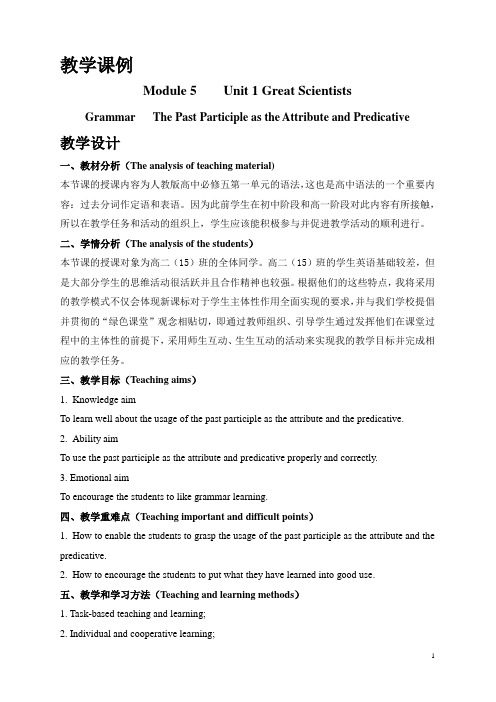
教学课例Module 5 Unit 1 Great ScientistsGrammar The Past Participle as the Attribute and Predicative教学设计一、教材分析(The analysis of teaching material)本节课的授课内容为人教版高中必修五第一单元的语法,这也是高中语法的一个重要内容:过去分词作定语和表语。
因为此前学生在初中阶段和高一阶段对此内容有所接触,所以在教学任务和活动的组织上,学生应该能积极参与并促进教学活动的顺利进行。
二、学情分析(The analysis of the students)本节课的授课对象为高二(15)班的全体同学。
高二(15)班的学生英语基础较差,但是大部分学生的思维活动很活跃并且合作精神也较强。
根据他们的这些特点,我将采用的教学模式不仅会体现新课标对于学生主体性作用全面实现的要求,并与我们学校提倡并贯彻的“绿色课堂”观念相贴切,即通过教师组织、引导学生通过发挥他们在课堂过程中的主体性的前提下,采用师生互动、生生互动的活动来实现我的教学目标并完成相应的教学任务。
三、教学目标(Teaching aims)1. Knowledge aimTo learn well about the usage of the past participle as the attribute and the predicative.2. Ability aimTo use the past participle as the attribute and predicative properly and correctly.3. Emotional aimTo encourage the students to like grammar learning.四、教学重难点(Teaching important and difficult points)1. How to enable the students to grasp the usage of the past participle as the attribute and the predicative.2. How to encourage the students to put what they have learned into good use.五、教学和学习方法(Teaching and learning methods)1. Task-based teaching and learning;2. Individual and cooperative learning;3. Brainstorming;六、教学辅助(Teaching aids)1.The multimedia;2.The learning paper;3.Other normal teaching tools七、教学过程(Teaching procedures)八、板书设计(Blackboard Design)课堂实录Step 1 GreetingStep 2 RevisionT: can you tell me what’s the grammar we learned in last unit?S: The usage of present participles.T: Good! We have learned the usage of present participles in last unit, so firstly, I’d like tolead you to have a revision about it . OK?S: OK!T: Now look at the screen, there are six sentences. Try to tell me what the underlined present participles are used for in these sentences? Clear?1.Walking in the street, he saw an old friend.2.Reading aloud is a good way in learning English.3.I tried to avoid making the same mistakes.4.I saw a boy getting on the bus.5.There is a swimming pool.6.The film we saw last night was very moving.S: Yes! They are used for adverbial/ subject/ object/ object complement/ attribute/ predicative/.(本部分用来复习上单元学习的现在分词的用法,从而引出非谓语的另一种形式----过去分词的用法)Step 3 warming-upT: Please take out your textbook and turn your book to page2 . Try to find out the sentences in the passage of where the past participles are used, and tell me what these past participles are used for? I will give you two minutes.( 2 mins later...)T: Have you finished it? What are these participles in the passage used for?S: Yes. They are used for the attribute and the predicative.(本部分通过从课文中找出含有过去分词作定语和表语的句子让学生对本节课的语法有着更直观的认识,从而有利于本节语法课的讲解。
新课标高中英语必修5 Unit 1 教案
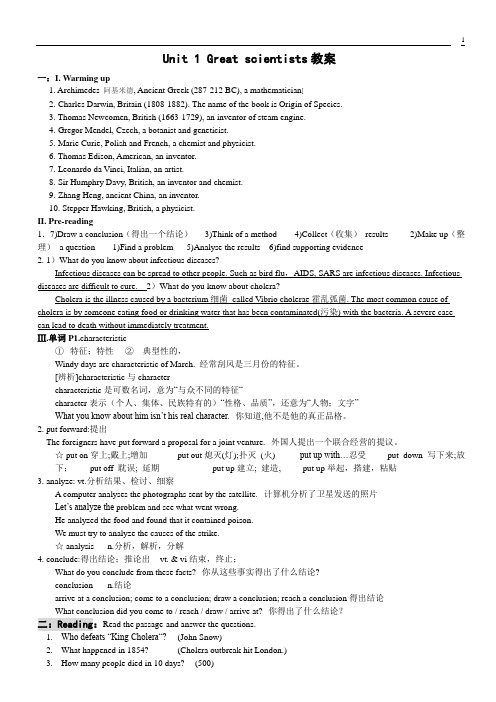
Unit 1 Great scientists教案一:I. Warming up1. Archimedes阿基米德, Ancient Greek (287-212 BC), a mathematician[2. Charles Darwin, Britain (1808-1882). The name of the book is Origin of Species.3. Thomas Newcomen, British (1663-1729), an inventor of steam engine.4. Gregor Mendel, Czech, a botanist and geneticist.5. Marie Curie, Polish and French, a chemist and physicist.6. Thomas Edison, American, an inventor.7. Leonardo da Vinci, Italian, an artist.8. Sir Humphry Davy, British, an inventor and chemist.9. Zhang Heng, ancient China, an inventor.10. Stepper Hawking, British, a physicist.II. Pre-reading1.7)Draw a conclusion(得出一个结论)3)Think of a method 4)Collect(收集)results 2)Make up(整理) a question 1)Find a problem 5)Analyse the results 6)find supporting evidence2. 1)What do you know about infectious diseases?Infectious diseases can be spread to other people. Such as bird flu,AIDS, SARS are infectious diseases. Infectious diseases are difficult to cure. 2)What do you know about cholera?Cholera is the illness caused by a bacterium细菌called Vibrio cholerae霍乱弧菌. The most common cause of cholera is by someone eating food or drinking water that has been contaminated(污染) with the bacteria. A severe case can lead to death without immediately treatment.Ⅲ.单词P1.characteristic①特征;特性②典型性的,Windy days are characteristic of March. 经常刮风是三月份的特征。
人教版英语必修五 Unit 1 全单元教案
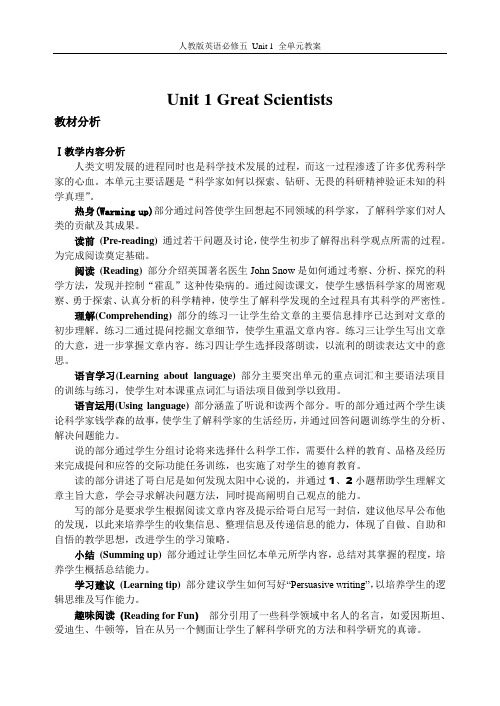
Unit 1 Great Scientists教材分析Ⅰ教学内容分析人类文明发展的进程同时也是科学技术发展的过程,而这一过程渗透了许多优秀科学家的心血。
本单元主要话题是“科学家如何以探索、钻研、无畏的科研精神验证未知的科学真理”。
热身(Warming up)部分通过问答使学生回想起不同领域的科学家,了解科学家们对人类的贡献及其成果。
读前(Pre-reading) 通过若干问题及讨论,使学生初步了解得出科学观点所需的过程。
为完成阅读奠定基础。
阅读(Reading) 部分介绍英国著名医生John Snow是如何通过考察、分析、探究的科学方法,发现并控制“霍乱”这种传染病的。
通过阅读课文,使学生感悟科学家的周密观察、勇于探索、认真分析的科学精神,使学生了解科学发现的全过程具有其科学的严密性。
理解(Comprehending) 部分的练习一让学生给文章的主要信息排序已达到对文章的初步理解。
练习二通过提问挖掘文章细节,使学生重温文章内容。
练习三让学生写出文章的大意,进一步掌握文章内容。
练习四让学生选择段落朗读,以流利的朗读表达文中的意思。
语言学习(Learning about language) 部分主要突出单元的重点词汇和主要语法项目的训练与练习,使学生对本课重点词汇与语法项目做到学以致用。
语言运用(Using language) 部分涵盖了听说和读两个部分。
听的部分通过两个学生谈论科学家钱学森的故事,使学生了解科学家的生活经历,并通过回答问题训练学生的分析、解决问题能力。
说的部分通过学生分组讨论将来选择什么科学工作,需要什么样的教育、品格及经历来完成提问和应答的交际功能任务训练,也实施了对学生的德育教育。
读的部分讲述了哥白尼是如何发现太阳中心说的,并通过1、2小题帮助学生理解文章主旨大意,学会寻求解决问题方法,同时提高阐明自己观点的能力。
写的部分是要求学生根据阅读文章内容及提示给哥白尼写一封信,建议他尽早公布他的发现,以此来培养学生的收集信息、整理信息及传递信息的能力,体现了自做、自助和自悟的教学思想,改进学生的学习策略。
高中英语必修五《unit1 Great Scientists》示范说课稿

《unit1 Great Scientists》说课稿各位评委老师,上午好!我是号考生,我今天说课的题目是《unit1 Great Scientists》。
我主要从教材分析、教学方法与策略、教学过程、板书设计等几个步骤向大家详细地讲解我对这节课的安排。
一.说教材1. 教材内容本节课是人教课标版必修5第一单元的第一课时的Reading部分,是该单元的主要内容,它介绍了英国著名医生John Snow是如何通过考察、分析、探究的科学方法,发现并控制“霍乱”这种传染病的。
通过阅读课文,使学生感悟科学家的周密观察、勇于探索、认真分析的科学精神,使学生了解科学方发现的全过程具有其科学的严密性。
2. 教学目标结合单元教学要求和本课特点,充分考虑学生的年龄特点、认知水平,遂将本课的教学目标确定为:知识目标1) Get students to learn the useful new words and expressions in this part.2) Let students learn about some great scientists and their contribution.3) Have students read the passage and know about John Snow and how he defeated “King Cholera”.能力目标1) Develop students’ reading ability and let them learn different reading skills.2) Enable students to talk about great scientists and tell their stories.情感目标1) Let students learn from great scientists, stimulate their love and respect for them and develop their moral qualities.2) Develop student’s sense of cooperative learning.3. 教学重点因为本组教材的重点了解项目是“John Snow 破解King Cholera难题”,所以确定本课的教学重点是:1) Let students learn about some great scientists and their contributions.2) Get students to read the passage and know about John Snow and how he defeated “ King Cholera”.3) Have students learn different reading skills.4.教学难点考虑到学生拓展阅读能力,语言输出能力等方面还需进一步努力,所以将本课的教学难点确定为:1) Develop students’ reading ability.2) Enable students to talk about great scientists and tell their stories.3) Let students learn how to organize scientific research.二.说教法和学法1. 教学方法引导学生独立思考,合作学习,进行师生、生生互动的“任务型”教学,设计了许多易于操作的任务型活动。
必修五Unit1教案设计
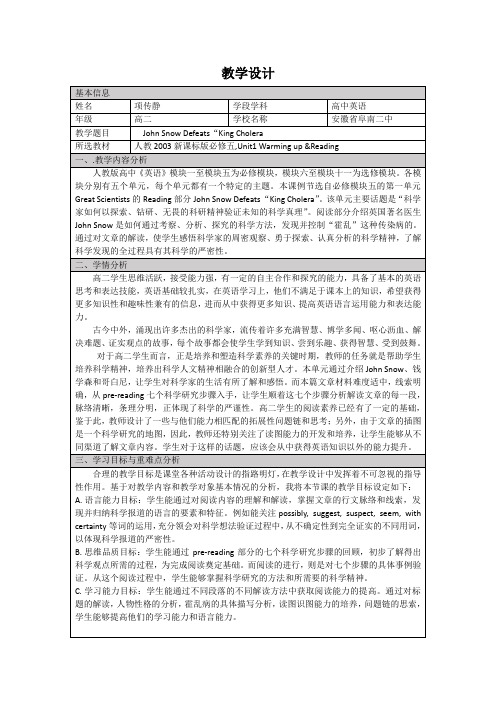
教学设计
Scan Para.5
What happened to the pump water?
Scan Para.6
What extra evidence did he find?
Scan Para.7
1. What did he suggest in order to prevent it from happening?
2. What happened finall y? 多,而有了小组的共同参与,个体的阅读压力能减小很多,而且也能让所有小组成员共同参与共同探讨,这本身就是
现;另外,读图能力也是科学能力当中非常重要的一种,因此,在这个过程中,笔者大胆采用了此方法,旨在提高学生的参与感和读图能力。
中文的句子和图片中的绘制相统一,让学生在寻找细节的同时也寻找原因所在,环环相扣,最后结论的给出也显得更加自然和流畅。
七、板书设计。
人教高中英语必修五:Unit+1教案-1.doc
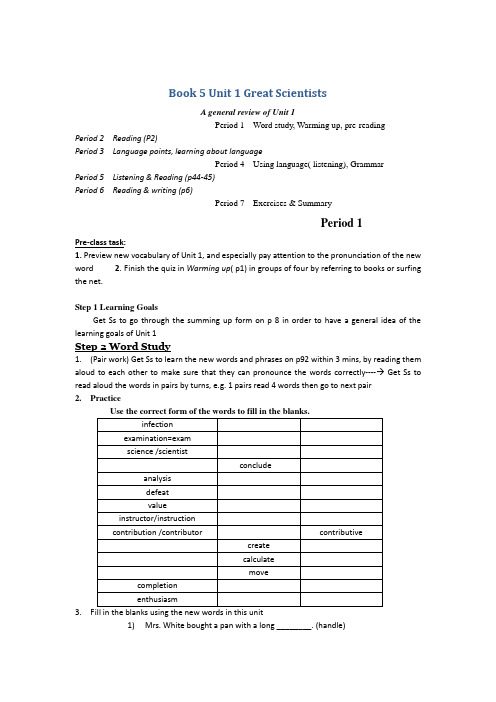
Book 5 Unit 1 Great ScientistsA general review of Unit 1Period 1 Word study, Warming up, pre-readingPeriod 2 Reading (P2)Period 3 Language points, learning about languagePeriod 4 Using language( listening), GrammarPeriod 5 Listening & Reading (p44-45)Period 6 Reading & writing (p6)Period 7 Exercises & SummaryPeriod 1Pre-class task:1. Preview new vocabulary of Unit 1, and especially pay attention to the pronunciation of the new word2. Finish the quiz in Warming up( p1) in groups of four by referring to books or surfing the net.Step 1 Learning GoalsGet Ss to go through the summing up form on p 8 in order to have a general idea of the learning goals of Unit 1Step 2 Word Study1. (Pair work) Get Ss to learn the new words and phrases on p92 within 3 mins, by reading them aloud to each other to make sure that they can pronounce the words correctly---- Get Ss to read aloud the words in pairs by turns, e.g. 1 pairs read 4 words then go to next pair2. Practice3.1)Mrs. White bought a pan with a long ________. (handle)2)The pollution is so ________ that we have to take some measures to stop it.(severe)3)He has a big nose that is a ________ of his family. (characteristic)4)Water and salt are ________ into our blood stream every day. (absorbed)5)If a doctor or a medical treatment ________ someone’s illness, they make theperson well again. (cure)6) A ________ is a kind of germ that can cause disease. (virus)Step 3. Warming up(Group competition) Check the answers to the quiz to find out which group know the most . Show pictures to introduce some scientists while Ss giving the correct answers-- congratulations to the winning groupStep 4 Pre-reading1. (Pair work) What five most important qualities do you think a scientist should have? Give reasons.clever/talented strict patient creative determined/strong-willed positivehonest energetic intelligent/hard-working ambitious careful co-operativeconfident brave2. (Group work) Ex2, p1Do you know how to prove a new idea in scientific research? Discuss in groups the stages in examining a new scientific idea. What order would you put them in?Draw a conclusion Think of a method Collect results Make up a question Find a problem Analyse the results Repeat if necessaryStep 5. Summary1.Seeing much, suffering much, and studying much are three pillars (支柱,要素) of learning.2.learning without thought is a labour lost; thought without learning is perilous(危险的)3. To know the disease is half the cure. 找出病根等于医治了一半。
高中英语《必修五第一单元单元词汇课》优质课教案、教学设计

教案设计(Learning about Language)部分由“词汇学习”和“语法学习”两项内容组成。
“词汇学习” 部分练习1 通过词的后缀训练名词与形容词之间的相互转换提倡学生使用词典。
练习2 选词填空练习,利用语篇集中训练本单元的一些重点词汇的用法。
练习3 是单句填空,而且所选的十个句子或是引文或是谚语。
“语法学习”部分主要是帮助学生了解、熟悉并掌握情态动词的用法,共有三项练习。
“语言运用”(Using Language)部分主要是让学生运用本单元所学的语言知识与课文内容进行听、说、读、写等的综合训练。
“听与说” (Listening and speaking); 是听前准备活动。
“读与写”(Reading and writing)主要设计是:阅读内容主要讲述一位来自高中的学生对全球变暖十分关注并向地球保护协会写了一封信询问措施。
协会给出了相当令人满意的回信。
短文后的三个问题帮助学生理解文章的内容。
写信的部分主要是要求学生根据上面阅读文章的内容通过思考写出自己的思想、自己的做法,尝试解决问题的不同途径。
教材提供给学生一些写作时要思考的问题,帮助学生完成写作构思。
“小结”(S ummin g U p)部分让学生根据所给出的提示对所学各项内容进行总结。
“学习建议”(L e a r nin g T ip)部分主要建议学生看阅读报纸,多读书多总结,以培养学生运用语言资源的能力。
五、教学重点Teaching important pointsa.The usage of language points of this unit.b.To learn to use these words.教学难点Teaching difficult pointsa.Enable students to get the hang of the language points completely.b.Get students to discuss warmly and express their own and excellent idea.教学方法Teaching methodsa.Brainstormingb.Task based language teaching.c.Individual, pair or group work to finish each task.d.Discussion.教学过程:1.concludevi.推断出vt.结束①conclude 推断出;断定conclude...with... 以...结束conclusion n .结论;结束arrive at/come to/reach/draw a conclusion 得出结论in conclusion 总而言之学生去说;学生能做的教师就不要代替学生去做;学生回答问题无论对还是错,教师不要急于评判,让学生自已去评判与总结;对发言积极的学生要及时鼓励,决不能因为他们的答案与教师的标准答案不一样就否定并伤害学生的自尊心。
人教版英语必修五Unit 1(John Snow defeats_King Cholera)教学教案
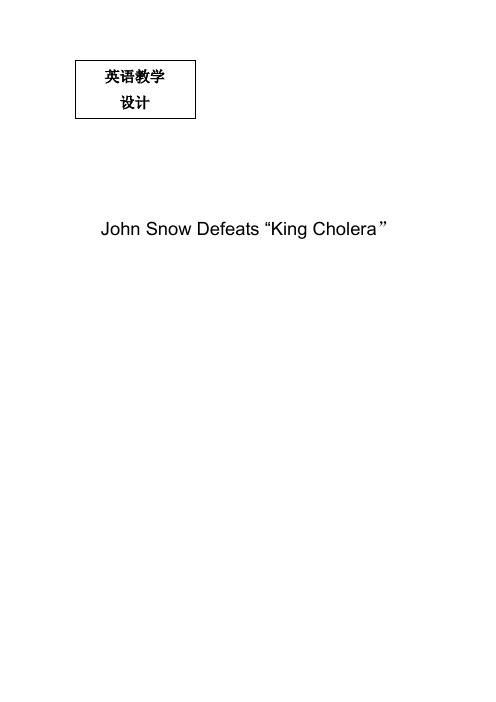
John Snow Defeats “King Cholera”Unit 1 John Snow Defeats “King Cholera”Teaching Goals:1. Enable the Ss to get to know some knowledge about Cholera.2. Enable the Ss to understand the passage well.3. Let the Ss learn some reading skills by scanning and skimming.4. To learn from the great scientists and develop the noble spirits . key points:1. To train the reading skills of skimming, scanning and careful reading;2. To master the details of the passage and appreciate the spirits of the scientists.Difficult points1. To develop the students’ ability of grasping the main idea of each paragraph.2. To get some detailed information by reading the text. Teaching methods1. Skimming & scanning2. Discussion methods3. Pair work of group4. CompetitionTeaching process:Step 1 Lead in本单元标题是伟大的科学家。
所以活动的设置为让学生说出自己熟知的科学家姓名、其发明、工作、生活的情况。
高二英语必修五unit1教案【高二英语必修五教案】

高二英语必修五unit1教案【高二英语必修五教案】高二网权威发布高二英语必修五教案,更多高二英语必修五教案相关信息请访问高二网。
The Sixth Period WritingTeaching goals 教学目标1. Target language 目标语言重点词汇与短语suggest, persuade, observation, contributions, achieve, devote ... to2. Ability goals 能力目标Enable the students to learn the way of persuasive writing and descriptive writing.3. Learning ability goals 学能目标Learn how to write a persuasive writing and a descriptive writing. Teaching important points教学重点Help the students to learn to write a persuasive writing and a report. Teaching difficult points教学难点How to write a report about a scientist and his / her job.Teaching methods 教学方法Task-based activities.Teaching aids 教具准备A computer and a projector.Teaching procedures & ways 教学过程与方式Step Ⅰ PresentationTask 1: Summarize the way of writing a report.T: Now class, if we want to write a report about a scientist, what contents should we include?S1: The life of the scientist, such as his birth and death dates, his family, his education, his personality, his achievements andcontributions, his key factors to his success.T: Yes. You are right. And how do we make an outline about it?S2: We should put the collected information under three headlines: life, achievements and key to success.Task 2: Remind the students of the writing techniques and writing features of a report.Show the following to the students.ReportFormal language with few adjectivesNo speech except quotationsNot emotionalOnly one main characterFactual structured according to experimental methodPast tense and passive voiceTask 3: Summarize the way of persuasive writing.T: You know if we want to persuade sb, we always want to reason with him or her. We must develop our own ideas and provide some evidence to support our ideas so there are always three steps to persuade somebody else to change his or her point of view. Can you point out what the three steps are?S1: I think the first is to give your opinion and idea.。
必修五unit1教案

必修五unit1教案教案标题:必修五 Unit 1 教案教学目标:1. 了解并理解本单元的主题和话题;2. 学习并掌握本单元的核心词汇和短语;3. 提高学生的听说读写能力;4. 培养学生的合作与交流能力。
教学重点:1. 掌握本单元的核心词汇和短语;2. 提高学生的听说读写能力。
教学难点:1. 运用所学知识和词汇进行口头和书面表达;2. 培养学生的合作与交流能力。
教学准备:1. 教材:必修五课本 Unit 1;2. 多媒体设备;3. 单词卡片、图片等教具。
教学过程:Step 1:导入(5分钟)1. 利用图片或实物引起学生对本单元主题的兴趣,激发学生的学习欲望;2. 导入本单元的主题和话题,引发学生对话题的思考和讨论。
Step 2:词汇学习(15分钟)1. 呈现并教授本单元的核心词汇和短语,使用各种教具和多媒体设备帮助学生理解和记忆;2. 组织学生进行词汇拓展活动,巩固新学词汇的掌握。
Step 3:听力训练(20分钟)1. 播放录音,让学生进行听力练习,理解对话和文章的主要内容;2. 组织学生进行听力理解的练习,如听后回答问题、听后填空等。
Step 4:口语训练(20分钟)1. 进行口语训练,组织学生进行对话练习,让学生在真实情景中运用所学知识进行口头表达;2. 利用小组活动或角色扮演,提高学生的口语表达能力和合作交流能力。
Step 5:阅读训练(15分钟)1. 学生阅读课文,理解文章的主要内容和细节信息;2. 组织学生进行阅读理解练习,如回答问题、填空等。
Step 6:写作训练(20分钟)1. 引导学生根据所学知识和词汇,进行写作训练,如写一篇关于旅行的短文、写一封邀请信等;2. 指导学生在写作过程中注意语法、词汇和句子结构的正确使用。
Step 7:复习与总结(10分钟)1. 复习本节课所学内容,巩固学生的知识掌握;2. 总结本节课的学习收获,鼓励学生积极参与课堂活动。
Step 8:作业布置(5分钟)布置相关的课后作业,如完成课本练习、写一篇关于旅行的短文、准备下节课的听力材料等。
人教版高中英语必修5 Unit1_Grammar_优教教学设计(一)
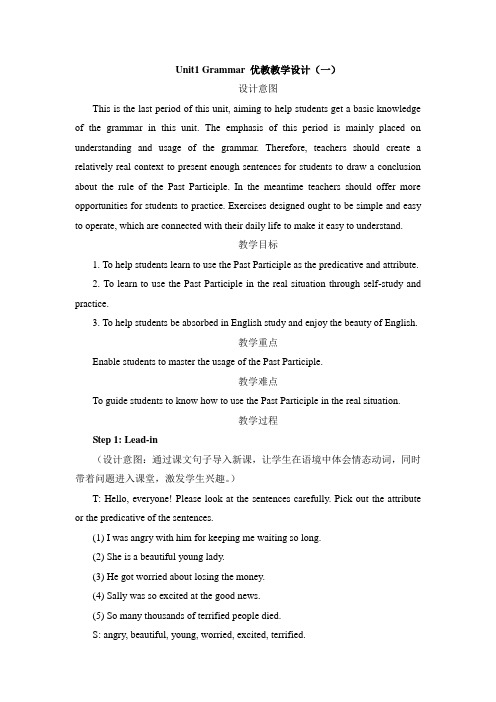
Unit1 Grammar 优教教学设计(一)设计意图This is the last period of this unit, aiming to help students get a basic knowledge of the grammar in this unit. The emphasis of this period is mainly placed on understanding and usage of the grammar. Therefore, teachers should create a relatively real context to present enough sentences for students to draw a conclusion about the rule of the Past Participle. In the meantime teachers should offer more opportunities for students to practice. Exercises designed ought to be simple and easy to operate, which are connected with their daily life to make it easy to understand.教学目标1. To help students learn to use the Past Participle as the predicative and attribute.2. To learn to use the Past Participle in the real situation through self-study and practice.3. To help students be absorbed in English study and enjoy the beauty of English.教学重点Enable students to master the usage of the Past Participle.教学难点To guide students to know how to use the Past Participle in the real situation.教学过程Step 1: Lead-in(设计意图:通过课文句子导入新课,让学生在语境中体会情态动词,同时带着问题进入课堂,激发学生兴趣。
2021-2022学年高中英语人教版必修五教学案:Unit 1 Section Ⅳ Word版含答案

SectionⅣLearningaboutLanguage&UsingLanguage对应同学用书P15[原文呈现]COPERNICUS' REVOLUTIONARY①THEORYNicolaus Copernicus②was frightened and his mind was confused③. Although he had tried to ignore them, all his mathematical calculations led to④the same conclusion that the earth was not the centre of the solar system⑤. Only if you put the sun there did⑥the movements⑦of the other planets in the sky make sense⑧. Y et he could not tell anyone about his theory as the powerful Christian Church⑨would have punished him for even suggesting such an idea. They believed God had made the world and for that reason⑩the earth was special and must be the centre of the solar system.[读文清障]①revolutionary [ˌrevə'luːʃənərI]adj.革命的;重大变革的②Nicolaus Copernicus ['nIkələs kəʊ'pɜːnIkəs]尼古拉·哥白尼(波兰天文学家)③confused adj.困惑的;苦恼的④lead to通向;导致⑤the solar system太阳系⑥only后接if引导的状语从句,主句使用部分倒装。
必修五 Unit1教案
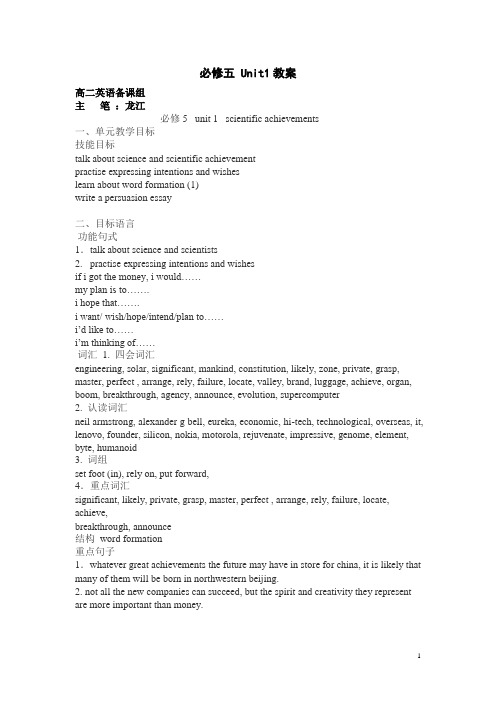
必修五 Unit1教案高二英语备课组主笔:龙江必修5 unit 1 scientific achievements一、单元教学目标技能目标talk about science and scientific achievementpractise expressing intentions and wisheslearn about word formation (1)write a persuasion essay二、目标语言功能句式1.talk about science and scientists2. practise expressing intentions and wishesif i got the money, i would……my plan is to…….i hope that…….i want/ wish/hope/intend/plan to……i’d like to……i’m thinking of……词汇1. 四会词汇engineering, solar, significant, mankind, constitution, likely, zone, private, grasp, master, perfect , arrange, rely, failure, locate, valley, brand, luggage, achieve, organ, boom, breakthrough, agency, announce, evolution, supercomputer2. 认读词汇neil armstrong, alexander g bell, eureka, economic, hi-tech, technological, overseas, it, lenovo, founder, silicon, nokia, motorola, rejuvenate, impressive, genome, element, byte, humanoid3. 词组set foot (in), rely on, put forward,4.重点词汇significant, likely, private, grasp, master, perfect , arrange, rely, failure, locate, achieve,breakthrough, announce结构word formation重点句子1.whatever great achievements the future may have in store for china, it is likely that many of them will be born in northwestern beijing.2. not all the new companies can succeed, but the spirit and creativity they represent are more important than money.三、教材分析与教材重组1. 教材分析通过学习了解人类的科学成就,帮助学生认识到这些成就深刻地改变了人类生产和生活的方式及质量,同时也深刻地改变了人类的思维观念和对世界的认识,改变并继续改变着世界的面貌,极大地推动了社会的发展。
人教版英语必修五 Unit 1 教案
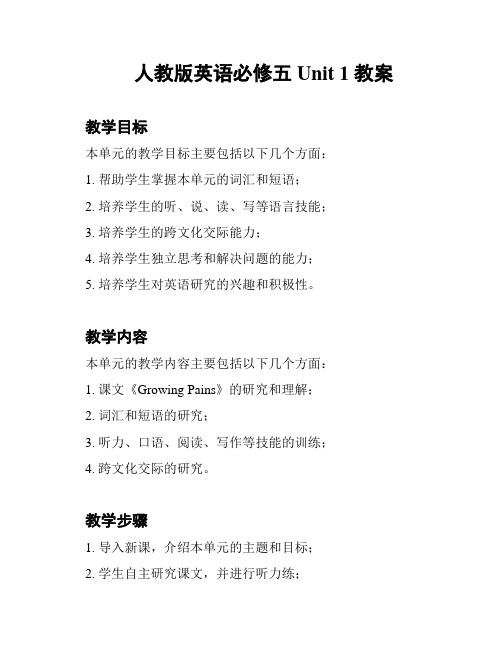
人教版英语必修五 Unit 1 教案教学目标本单元的教学目标主要包括以下几个方面:1. 帮助学生掌握本单元的词汇和短语;2. 培养学生的听、说、读、写等语言技能;3. 培养学生的跨文化交际能力;4. 培养学生独立思考和解决问题的能力;5. 培养学生对英语研究的兴趣和积极性。
教学内容本单元的教学内容主要包括以下几个方面:1. 课文《Growing Pains》的研究和理解;2. 词汇和短语的研究;3. 听力、口语、阅读、写作等技能的训练;4. 跨文化交际的研究。
教学步骤1. 导入新课,介绍本单元的主题和目标;2. 学生自主研究课文,并进行听力练;3. 进行课文的理解和讨论,引导学生思考和表达观点;4. 研究和掌握本单元的词汇和短语;5. 进行听说训练,提高学生的口语表达能力;6. 进行阅读和写作训练,培养学生的阅读理解和写作技能;7. 进行跨文化交际的研究,增进学生对英语和其他文化的认识。
教学评价本单元的教学评价主要以以下方式进行:1. 各种形式的课堂练和作业,检测学生对知识的掌握程度;2. 口语和写作表现的评价,评估学生语言运用的能力;3. 学生参与课堂讨论和发言的情况,评估学生的思维能力和表达能力。
教学资源本单元的教学资源包括以下几个方面:1. 课本《人教版英语必修五》;2. 音频材料;3. 多媒体设备;4. 教学课件和作业练册。
以上为《人教版英语必修五 Unit 1 教案》的简要内容,旨在帮助教师设计和安排本单元的教学活动。
具体的教学步骤和细节应根据实际情况进行调整和完善。
高中英语必修五_unit1_教案新部编本
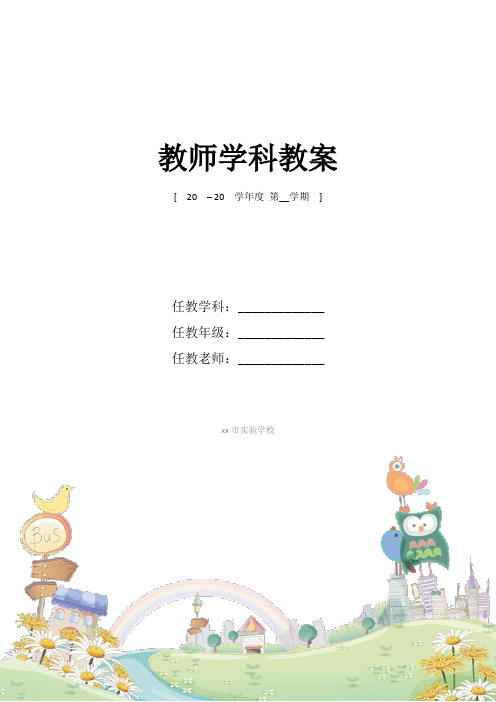
教师学科教案[ 20 – 20 学年度第__学期]任教学科:_____________任教年级:_____________任教老师:_____________xx市实验学校Unit 1 Great scientistsCopernicus’ revolutionary theoryTeaching aims:1 Improve the Ss reading and writing skill.2 Get to know Copernicus’ revolutionary theory.3 Learn some useful words and expressions.Main points:Reading and writingDifficult points:ComprehensionTeaching procedures:Step1. Lead-inAsk the students to name some great scientists, lead out Nicolaus Copernicus by present his picture on the PPT, and introduce him simply.Step2. Reading1 Give the students 10 minutes to read the passage and find the answer of the four questions by group work• a What did Copernicus think was the center of the solar system?• b Why Copernicus couldn’t he tell anyone about the theory?• c How many years did Copernicus work on the problem to complete his theory?• d When did Copernicus publish his theory?Then, check the answer before asking some students to answer2 Let Ss draw the two theories of the universe on P73 Let Ss judge the sentences which present the information of the text to check if they have got the passage generally.4 Language points: Let the student read the passage paragraph by paragraph to pick out the problems they have.The points may be:a.lead to: All roads lead to Rome.b.冒号+that从句(可略):尽管他很聪明,但他不勤奋,他从失败中得出结论:不劳无获Though he was very clever, he didn’t work hard and all his failure led to the conclusion: that no pain no gain.c.Only if you put the sun there did the movements of the other planets in the skymake sense.只有当你把太阳放在中心位置上,天空中其他行星的运动才能说的清楚Only 引导的状语放在句首,句子需用半倒装For example:只有用这种方法,你才能轻松得解决这个问题Only in this way, can you deal with the problem easily.就在你失去它的时候,你才会懂得时间宝贵。
人教必修五unit1reading教案

Unit1 Great ScientistReading and warming upTeaching Goals:1. Enable the Ss to familiar with some famous scientists and their contributions.2. Enable the Ss to learn how to organize a scientific research.3. Let the Ss learn the reading skill of getting the main idea of each para./ part & each passage .Important pointsImprove the students’ reading ability.Difficult points1. How to grasp the main idea of each paragraph / part & each passage.2. How to help the Ss use what they’ve learnt to do first aid treatment for burns correctly.Teaching methods1). Skimming & scanning methods to make the Ss get a good understanding of the text.1.Discussion methods to make the Ss understand what they’ve learned in class.2.Pair work of group to get every student to take part in the teaching-and-learningactivities.petition and role-play method to arouse the Ss’ interestTeaching aidsThe multi-media (see a short movie about how to treat burn from ppt.) Teaching proceduresI. Warming up1.Lead-in 1) Show a picture of AIDS logo to lead in the subject—AIDS ?Are you familiar with this red ribbon?What’s it related to? ? What doesn’t it mean? Do you know?(Possible answer: Red ribbon is related to AIDS. It means that we should give AIDS patients love and care, understand and support.)2) Show a picture of Pu Cunxin and other stars to show that AIDS is a worldwide problem. ? Do you know them?What is their job besides acting?Is it just the problem in China?(Possible answer: It’s not just the problem in China. It’s a worldwide problem. And besides some famous stars, some ordinary people also work very hard to tell others the harm of this disease.)2.Brain stormingQ1: While talking about AIDS, what other diseases can you think of? Individual work: Let students brainstorm the names of diseases, such as cold, headache, toothache, diarrhea, cut, coughing, scald, insomnia, heart attack, cancer, AIDS, etc.(With the development of science and hi-tech, many diseases can be cured. But for now, AIDS is still incurable, so it’s a deadly disease.)3.How much do you know about AIDS?1) Pair work—questions for discussion ? What’s the full name of AIDS?Can AIDS be transmitted? ? In what ways can it be transmitted?What kinds of people are likely to get AIDS?Do people with AIDS look healthy at first?Is it safe or dangerous to stay or to be friends with them? Why? Students don't have to give the exact answers. These questions will help them think about this disease? AIDS.)AIDS QUIZ (individual work)AIDS quiz (p.49)?check students? knowledge about AIDS.2) Picture quiz ?Can the AIDS virus transmitted via the following routes?Summary: Medical studies show that the AIDS virus cannot be transmitted via the following routes: cups, glasses, toilet seats, swimming pools, mosquitoes, other insects or giving blood. So it? safe to be friends with AIDS patients. II. Listening (WB)1.Pre-listening: Go through EX1&2 in Part1 and guess ?What do the letters HIV andAIDS stand for?2.While-listening: Listen to the tape and finish exercises in Part1&2. (Make good useof some pictures and a flash ?HIV-cycle? in the PowerPoint)3.Post-listening: Suppose you are a publicist of AIDS, please give an oral reportabout it to the whole class.III. Talking (Optional) Role play:Work in groups. Imagine that the headmaster of a school has found out that one of the students has HIV. The student’s family has kept it a secret until now and the headmaster only learnt the truth last week. He had called a meeting to decide what to do. (Opinions can be based on their knowledge of AIDS and also the characteristics of the roles.)IV. Homework1.Preview Speaking (p. 50) and find some information about AIDS, drugs, smokingor drinking to support your idea.2. Learn the new words of this unit by heart.。
必修五unit1教案
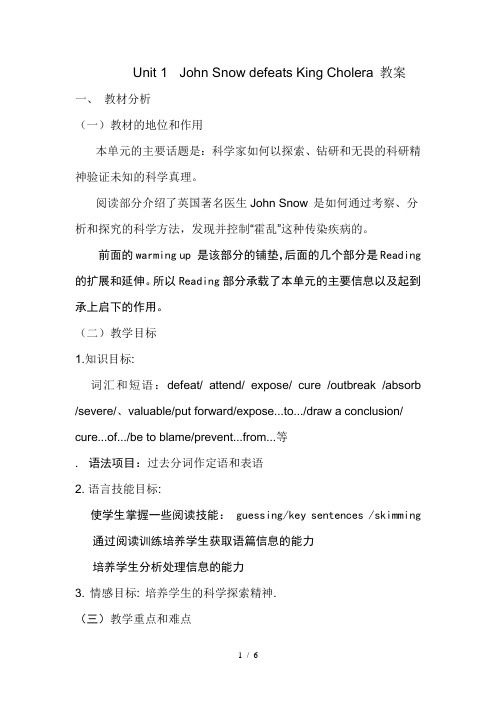
Unit 1 John Snow defeats King Cholera 教案一、教材分析(一)教材的地位和作用本单元的主要话题是:科学家如何以探索、钻研和无畏的科研精神验证未知的科学真理。
阅读部分介绍了英国著名医生John Snow 是如何通过考察、分析和探究的科学方法,发现并控制“霍乱”这种传染疾病的。
前面的warming up 是该部分的铺垫,后面的几个部分是Reading 的扩展和延伸。
所以Reading部分承载了本单元的主要信息以及起到承上启下的作用。
(二)教学目标1.知识目标:词汇和短语:defeat/ attend/ expose/ cure /outbreak /absorb /severe/、valuable/put forward/expose...to.../draw a conclusion/ cure...of.../be to blame/prevent...from...等. 语法项目:过去分词作定语和表语2. 语言技能目标:使学生掌握一些阅读技能: guessing/key sentences /skimming 通过阅读训练培养学生获取语篇信息的能力培养学生分析处理信息的能力3. 情感目标: 培养学生的科学探索精神.(三)教学重点和难点重点:通过阅读,掌握词汇、句型,提高学生的阅读水平。
难点:通过阅读,进行分析归纳;过去分词作定语和表语。
二、学情分析高二学生经过高中一年的语言学习,已经初步掌握了阅读文章的方法,有一定的分析、概括能力。
他们的英语基础知识和基本技能处在一个逐步上升的阶段。
因此,我将引导学生自主参与学习、交流合作,使学生在自主与合作的学习方式中获取知识,形成正确的学习方法。
实现阅读能力的提高。
三、Teaching method 教学方法根据本单元的主题及内容,为了突出重点,达到预定的教学目标,我将采用:cooperative Learning approach合作学习教学法.task-based teaching and learning approach任务型语言教学法 communicative Approach交际教学法discussion/practicing/summarizing 等。
- 1、下载文档前请自行甄别文档内容的完整性,平台不提供额外的编辑、内容补充、找答案等附加服务。
- 2、"仅部分预览"的文档,不可在线预览部分如存在完整性等问题,可反馈申请退款(可完整预览的文档不适用该条件!)。
- 3、如文档侵犯您的权益,请联系客服反馈,我们会尽快为您处理(人工客服工作时间:9:00-18:30)。
人教版高中英语必修5教案Unit 1 Great scientistsPeriod 1 Warming up and readingLearning aims:1. To help students learn to describe people2. To help students learn to read a narration about John Snow3. To help students better understand “Great scientists”Important Points:To help students learn to read a narration about John Snow Difficult Points:To help students learn to describe peopleTeaching Procedures:Ⅰ. Warming upStep I Lead inTalk about scientist.T: Hi, morning, class. Nice to see you on this special day, the day when you become a senior two grader. I am happy to be with you helping you with your English. Today we are to read about a certain scientist. But first let’s define the word “scientist”. What is a scientist?A scientist is a person who works in science, trying to understand how the universe or other things work.Scientists can work in different areas of science. Here are some examples: Those that study physics are physicists. Those that study chemistry are chemists. Those that study biology are biologists.Step II BrainstormingAsk the students to try the quiz and find out who knows the most.T: There are some great scientific achievements that have changed the world. Can you name some of them? What kind of role do they play in the field of science? Do these achievements have anything in common? Match the inventions with their inventors.II. Pre-readingGet the students to discuss the questions on page 1 with their partners. Then ask the students to report their work. Encourage the students to express their different opinions.1.What do you know about infectious diseases?2.What do you know about cholera?3. Do you know how to prove a new idea in scientific research?III. ReadingStep I Pre-reading1.Do you know John Snow?2.Do you know what kind of disease is cholera?Let’s get to know how Dr. John Snow defeated “King Cholera” in 1854 in London in this reading passage:Step II SkimmingRead the passage and answer the questions.1.Who defeats “King Cholera“? (John Snow)2.What happened in 1854? (Cholera outbreak hit London.)3.How many people died in 10 days? (500)4.Why is there no death at No. 20 and 21 Broad Street as well as at No. 8 and 9Cambridge Street?(These families had not drunk the water from the Broad Street pump.)(Optional)Skim the passage and find the information to complete the form below.Who WhenWhat How ResultJohn Snow 1854 helpingordinarypeopleexposed tocholeraExamining the sourceof all water suppliesand finding newmethods of dealingwith polluted waster“King Cholera”defeatedStep III ScanningRead the passage and number these events in the order that they happened.2 John Snow began to test two theories.1 An outbreak of cholera hit London in 1854.4 John Snow marked the deaths on a map.7 He announced that the water carried the disease.3 John Snow investigated two streets where the outbreak was very severe.8 King Cholera was defeated.5 He found that most of the deaths were near a water pump.6 He had the handle removed from the water pump.Step IV Main idea and correct stageRead the passage and put the correct stages into the reading about research into a disease.John Snow Defeats “King Cholera”ParagraphStages General ideas1 Find a problem:What cause the cholera?The causes of cholera2 Make up a question:Which is right?The correct or possible theory3 Think of a method:Test two theoryCollect data on where people were ill anddied and where they got their water4 Collect results:Mark the deathPlot information on a map to find outwhere people died or did not die5 Analyze the results:Find the resource of thewaterLook into the water to see if that is thecause of the illness6 Find supporting evidence Find other evidences to confirm hisconclusion7 Draw a conclusion The polluted dirty source of drinkingwater was to blame for the cause of theLondon choleraStep V Group discussionAnswer the questions (Finish exercise 2 on Page 3)1. John Snow believed Idea 2 was right. How did he finally prove it?(John Snow finally proved his idea because he found an outbreak that was clearly related to cholera, collected information and was able to tie cases outside the area to the polluted water.)2. Do you think John Snow would have solved this problem without the map?(No. The map helped John Snow organize his ideas. He was able to identify those households that had had many deaths and check their water-drinking habits. He identified those houses that had had no deaths and surveyed their drinking habits. The evidence clearly pointed to the polluted water being the cause.)3. Cholera is a 19th century disease. What disease do you think is similar to cholera today?(Two diseases, which are similar today, are SARS and AIDS because they are both serious, have an unknown cause and need public health care to solve them.) Step VI SummaryUsing the stages for scientific research and write a summary.Period 2&3 Language focusLearning aims: To help students learn to use some important words and expressions Important Points:To help students learn to remember some important words and expressionsDifficult Points: To help students learn to use some important words and expressions Teaching Procedures:Step I Warming up1.characteristic①n. a quality or feature of sth. or someone that is typical of them and easy torecongnize.特征;特性What characteristics distinguish the Americans from the Canadians.② a. very typical of a particular thing or of someone’s characer 典型性的,Such bluntness is characteristic of him.Windy days are characteristic of March.[辨析]characteristic与charactercharacteristic是可数名词,意为“与众不同的特征“character表示(个人、集体、民族特有的)“性格、品质”,还意为“人物;文字”What you know about him isn’t his real character.2. put forward: to state an idea or opinion, or to suggest a plan or person, for other people to consider提出He put forward a new theory.The foreigners have put forward a proposal for a joint venture.An interesting suggestion for measuring the atmosphere around Mars has been put forward.☆ put on穿上;戴上;增加put out熄灭(灯);扑灭(火) put up with…忍受put down写下来;放下; put off 耽误; 延期put up建立; 建造,put up举起,搭建,粘贴3. analyze: to examine or think about something carefully in order to understand it vt.分析结果、检讨、细察A computer analyses the photographs sent by the satellite.The earthquake expert tried to analyze the cause of the earthquake occurred on May 12,2008.Let’s analyze the problem and see what went wrong.He analyzed the food and found that it contained poison.We must try to analyze the causes of the strike.☆ analysis n.分析,解析,分解4. conclude: decide that sth. is true after considering al the information you have 得出结论;推论出to end sth. such as a meeting or speech by doing or saying one final thing vt. & vi结束,终止;We concluded the meeting at 8 o’clock with a prayer.From his appearance we may safely conclude that he is a heavy smoker.What do you conclude from these facts?We conclude to go out / that we would go out.conclusion n.结论arrive at a conclusion; come to a conclusion; draw a conclusion; reach a conclusionWhat conclusion did you come to / reach / draw / arrive at?From these facts we can draw some conclusions about how the pyramids were built.Step 2 Reading1. defeat① vt. to win a victory over someone in a war, competition, game etc.打败,战胜,使受挫I’ve tried to solve the problem, but it defeats me!Our team defeated theirs in the game.② n.失败,输failure to win or succeedThis means admitting defeat.They have got six victories and two defeats.[辨析]win, beat与defeat①win “赢得”赛事、战事、某物;后接人时,意为“争取赢得…的好感或支持;说服”②beat “战胜”“击败”比赛中的对手,可与defeat互换We beat / defeated their team by 10 scores.They won the battle but lost many men.The local ball team won the state championship by beating / defeating all the other teams.I can easily beat /defeat him at golf.He is training hard to win the race and realize his dream of becoming a champion at the 2008 Olympic Games.2. expert① n. someone who has a special skill or special knowledge of a subject专家,能手an expert in psychology an agricultural expert② a. having special skill or special knowledge of a subject熟练的,有专门技术的an expert rider an expert job需专门知识的工作He is expert in / at cooking.3. attend vt. &vi 参加,注意,照料① be present at参加attend a ceremony / lecture / a movie / school / class / a meetingI shall be attending the meeting.Please let me know if you are unable to attend the conference.② attend to (on): to look after, care for, serve伺候, 照顾,看护The queen had a good doctor attending on her.Dr Smith attended her in hospital. 治疗Are you being attended to?接待Mother had to attend to her sick son.③ attend to处理,注意倾听attend to the matterA nurse attends to his needs.Can you attend to the matter immediately?I may be late – I have got one or two things to attend to.Excuse me, but I have an urgent matter to attend to.[辨析]attend, join, join in与take part in①attend指参加会议、上课、上学、听报告等②join 指加入某组织、团体,成为其中一员③join in指加入某种活动;表示与某人一起做某事join sb. in sth.④take part in指参加正式的、有组织的活动,切在活动中起积极作用Only 2 people attended the meeting.He joined the Communist Youth League in 2007.Will you join us in the game?We often tale part in the after-class activities.4. expose : to show sth. that is usually covered暴露expose sth. to the light of day 把某事暴露于光天化日之下I threatened to expose him ( to the police). 我威胁要(向警察)揭发他.He exposed his skin to the sun.他把皮肤暴露在阳光下.The old man was left exposed to wind and rain.When he smiled he exposed a set of perfect white teeth.5. cure vt. & n. to make someone who is ill well agian治疗,痊愈When I left the hospital I was completely cured.①cure sb of a diseaseWhen you have a pain in your shoulders, you will go to see a doctor. The doctor will cure you.The only way to cure backache is to rest.He will cure the pain in your shouldersWhen I left the hospital I was completely cured.The illness cannot be cured easily.Although the boy was beyond cure, his parents tried to cure him of bad habits.②a cure for a diseaseAspirin is said to be a wonderful cure for the pain.There is still no cure for the common cold.Is there a certain cure for cancer yet?③a cure for sth.: to remove a problem, or improve a bad situation解决问题,改善困境The prices are going up every day, but there is no cure for rising prices.[辨析]cure与treat①cure主要指痊愈,强调的是结果②treat强调治疗过程,指通过药物、特别的食品或运动治疗病人或疾病,不强调结果。
